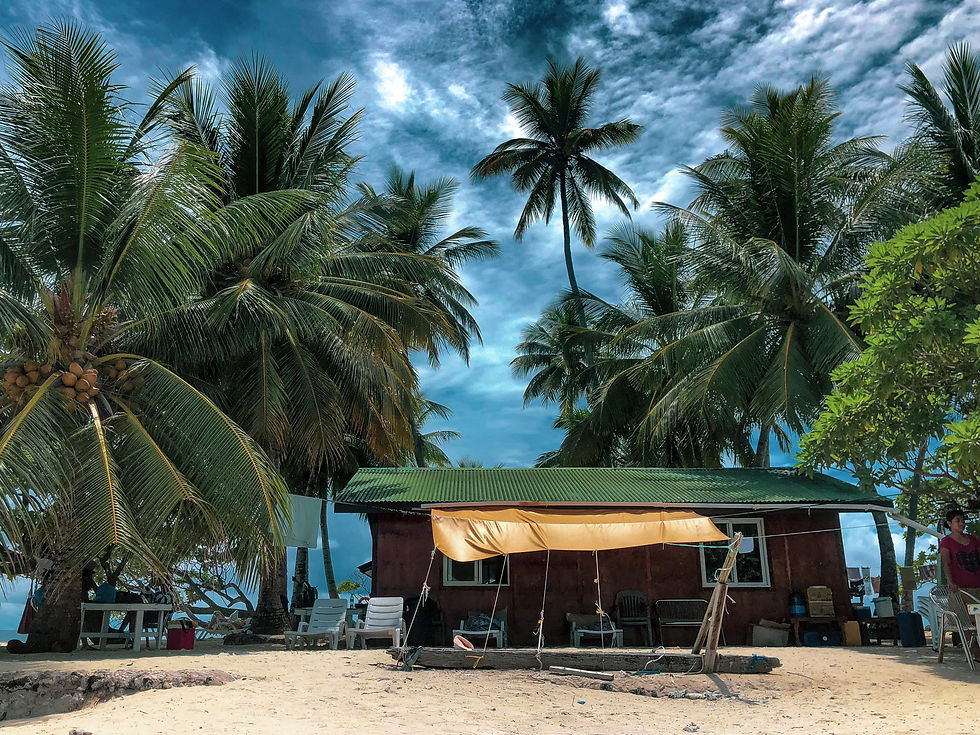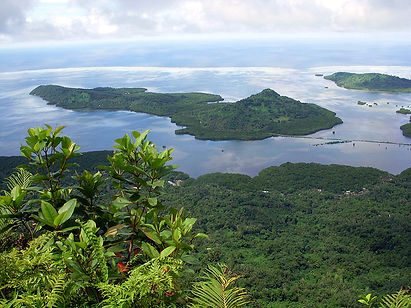Country Info | Read more
Flags are sourced from free platforms like flagpedia.net
Micronesia
Micronesia offers pristine islands, vibrant marine life, and lush landscapes. Dive into Chuuk Lagoon, explore Pohnpei, and enjoy serene Pacific getaways.
Photos without credits are sourced from free platforms like Unsplash and Pexels





Summary
Neighboring Countries
Overview
Months
01. January, 02. February
Vacation type
Beach, Couple, Family, Nature
Expenses
<150€, <200€, Over 200€
Temperature
Over 30°C, 25-30°C
Rainfall
>200mm
Safety
Medium
Continent
Oceania
Currency
Australian dollar, U.S dollar
Languages
English
Currency Converter
When to visit
The best time to visit Micronesia is during the dry season, which generally spans from December to April. During this period, you can expect more stable weather conditions, lower humidity, and less rainfall, making it ideal for outdoor activities and exploring the islands.
- December to April: Features drier conditions with less rainfall and moderate temperatures, which is perfect for snorkeling, diving, and enjoying the natural beauty of the islands.
The rainy season runs from May to November, bringing higher humidity, increased rainfall, and a higher likelihood of tropical storms. While this period can still be warm and lush, frequent heavy showers and potential storms may disrupt travel plans and outdoor activities.
Weather, Crowds and Costs
Per one person
Tourist Season: December-April (Dry Season)
Budget Vacation ($40-80/day)
Accommodation: $20-40/night (budget guesthouses, hostels).
Food: $10-20/day (local food, casual restaurants).
Activities: $10-15/day (beach activities, cultural visits).
Transportation: $5-10/day (local transport).
Other Costs: $5-10/day (souvenirs).
Mid-Range Vacation ($100-200/day)
Accommodation: $40-100/night (mid-range hotels).
Food: $20-40/day (restaurants, local meals).
Activities: $10-30/day (snorkeling, nature tours).
Transportation: $10-20/day (taxis, bike rentals).
Other Costs: $5-10/day (shopping).
Luxury Vacation ($200+/day)
Accommodation: $100+/night (luxury resorts, hotels).
Food: $30+/day (fine dining).
Activities: $30+/day (private excursions, luxury experiences).
Transportation: $15+/day (private transport).
Other Costs: $10+/day (luxury shopping).
Off-Peak Season: May-November (Rainy Season)
Budget Vacation ($30-60/day)
Accommodation: $15-30/night (budget guesthouses).
Food: $5-15/day (local meals).
Activities: $5-10/day (beach activities, nature walks).
Transportation: $5-10/day (local transport).
Other Costs: $5/day (souvenirs).
Mid-Range Vacation ($70-150/day)
Accommodation: $30-60/night (mid-range hotels).
Food: $10-30/day (cafes, local restaurants).
Activities: $10-20/day (snorkeling, hiking).
Transportation: $5-15/day (local transport).
Other Costs: $5-10/day (shopping).
Luxury Vacation ($150+/day)
Accommodation: $60+/night (luxury hotels, resorts).
Food: $20+/day (fine dining).
Activities: $20+/day (private tours, excursions).
Transportation: $10+/day (private transport).
Other Costs: $10+/day (luxury shopping).
Best Regions to visit
Cities
1. Palikir
- The capital city of the Federated States of Micronesia, located on the island of Pohnpei, known for its governmental and cultural significance.
2. Kolonia
- A key town on the island of Pohnpei, offering historical sites, local markets, and access to natural attractions like Nan Madol.
3. Weno
- The largest city in the Chuuk State, known for its proximity to the Chuuk Lagoon, a famous diving destination with numerous shipwrecks.
4. Colonia
- Located on Yap Island, Colonia is known for its traditional culture, stone money, and nearby diving spots.
5. Tofol
- The main town on Kosrae Island, offering a peaceful atmosphere, local markets, and access to natural sites such as the Lelu Ruins.
Chuuk

Islands
1. Pohnpei
- Known for its lush rainforests, waterfalls, and the ancient ruins of Nan Madol.
2. Chuuk Lagoon
- Famous for its underwater shipwrecks from World War II, making it a top destination for divers.
3. Yap
- Renowned for its traditional culture, stone money, and excellent diving with manta rays.
4. Kosrae
- A quieter island known for its pristine coral reefs, hiking trails, and ancient ruins.
5. Ant Atoll
- A remote and stunning atoll near Pohnpei, perfect for snorkeling, diving, and enjoying unspoiled nature.
Things to see
Natural Attractions
1. Chuuk Lagoon
- Dive into this world-renowned underwater museum, where you can explore numerous sunken WWII ships and planes, now home to vibrant marine life.
2. Nan Madol
- Explore this ancient, mysterious city built on a series of artificial islands, often referred to as the "Venice of the Pacific," with impressive stone ruins dating back centuries.
3. Pohnpei Waterfalls
- Hike through lush jungles to discover a series of stunning waterfalls, such as Kepirohi and Liduduhniap, perfect for swimming and picnicking.
4. Yap Stone Money
- Visit the iconic stone money banks, where enormous stone discs, some weighing several tons, serve as a unique form of currency and a symbol of Yapese culture.
5. Kosrae's Coral Reefs
- Snorkel or dive in the clear waters around Kosrae, known for some of the healthiest and most pristine coral reefs in the Pacific, teeming with marine life.
6. Ant Atoll
- Enjoy a day trip to this uninhabited atoll near Pohnpei, a UNESCO Biosphere Reserve, known for its stunning beaches, clear lagoons, and excellent snorkeling opportunities.
Cultural Attractions
1. Pohnpei’s Traditional Villages
- Immerse yourself in the local culture by visiting traditional villages, where you can learn about Micronesian customs, crafts, and daily life.
2. Yap's Men's Houses (Faluw)
- Explore these traditional structures used for community gatherings and rituals, often beautifully decorated with carvings and symbolic designs.
3. Kosrae’s Lelu Ruins
- Discover the ancient ruins of Lelu, a once-great city with remnants of royal tombs, stone walls, and other archaeological treasures.
4. Sokehs Ridge
- Hike up to this historical site on Pohnpei, where you can find old Japanese gun emplacements from WWII, along with stunning panoramic views of the island.
5. Chuuk Cultural Village
- Experience traditional Chuukese culture through demonstrations of local crafts, dancing, and storytelling in an authentic setting.
6. Micronesia’s Traditional Navigation
- Learn about the ancient art of celestial navigation, still practiced in some parts of Micronesia, where navigators use stars, ocean swells, and other natural cues to guide their way across vast distances.
Small Island

How to get around
1. Domestic Flights
- Domestic flights are essential for traveling between the islands in Micronesia. United Airlines and Pacific Missionary Aviation offer flights connecting major islands and regions, such as Yap, Chuuk, Pohnpei, and Kosrae.
2. Boats
- Boats are commonly used for inter-island travel and exploring smaller islands and atolls. Local ferries and private charters are available for navigating between islands and enjoying scenic trips.
3. Car Rentals
- Renting a car is a practical option for exploring larger islands such as Pohnpei and Yap. It provides flexibility for visiting local attractions and beaches. Some islands have limited rental options, so it’s a good idea to book in advance.
4. Taxis
- Taxis are available in larger towns and cities, such as Colonia on Yap and Pohnpei State Capital. They are useful for short trips around town or to nearby attractions. It’s advisable to negotiate fares or use metered taxis if available.
5. Local Transportation
- In some areas, local buses or shared transport options may be available for getting around town or between nearby islands. These are less common but can be useful for local travel.
6. Bicycles and Scooters
- Renting a bicycle or scooter can be a fun and flexible way to explore smaller islands or coastal areas. This option is more common in places like Pohnpei and Kosrae.
7. Walking
- Walking is feasible in compact towns and areas where many attractions are close together. It’s an enjoyable way to explore local neighborhoods and markets.
For the best experience, use domestic flights for inter-island travel, boats for island-hopping, and car rentals for exploring larger islands. Taxis and local transport are useful for short trips, and consider bicycles or walking for local exploration.
What to eat
1. Taro
- A staple root vegetable often served boiled or mashed, showcasing local agriculture.
2. Fried Breadfruit
- Sliced and fried breadfruit, enjoyed as a snack or side dish.
3. Coconut Crabs
- A delicacy prepared in various ways, often steamed or baked.
4. Palusami
- Taro leaves cooked in coconut milk, often served as a side dish.
5. Sashimi
- Freshly caught fish served raw, showcasing the island's seafood.
Flights
Flight prices are approximate and vary by departure city, airline, and booking time. Check airlines or travel platforms for the latest details.
Main Airport: Pohnpei International Airport (PNI)
Flight Prices and Seasons:
From Europe
- Average Round-Trip Cost: €900 to €1,500.
- Cheapest Months: February to March and September to November.
- Peak Prices: Summer (June to August) and December holidays.
From North America
- Average Round-Trip Cost: $700 to $1,300.
- Cheapest Months: February to March and September to November.
- Peak Prices: Summer and December holidays.
From Asia
- Average Round-Trip Cost: $500 to $900.
- Cheapest Months: February to March and October.
- Peak Prices: December holidays and summer months.
From Australia
- Average Round-Trip Cost: $900 to $1,500.
- Cheapest Months: February to March and September.
- Peak Prices: December holidays and summer months.
From Africa
- Average Round-Trip Cost: $800 to $1,500.
- Cheapest Months: February to March and September to November.
- Peak Prices: Summer and December holidays.
Visa
1. Visa Requirement
- Many travelers, including citizens of the U.S., Canada, the U.K., and Australia, do not need a visa for short visits.
2. Visa-Free Entry
- Citizens from several countries can enter visa-free for stays of up to 30 days.
3. Visa on Arrival
- Travelers can obtain a visa on arrival for stays of up to 30 days, which can be extended for an additional 30 days.
4. Visa Application
- Travelers from countries that require a visa must apply for a Micronesian visa at a Micronesian embassy or consulate before traveling.
5. Types of Visa
- Common visa types include a Tourist Visa: Valid for short stays, typically up to 30 days.
6. Processing Time
- Visa processing can vary, so it’s advisable to apply well in advance if required.
7. Duration of Stay
- Visa-free visitors can stay for up to 30 days, with the possibility of extension.
8. Health Requirements
- No specific vaccinations are generally required, but travel insurance is recommended.
9. COVID-19 Regulations
- Check for any current COVID-19 entry requirements before traveling, as regulations may change.
Important things to know
1. Payments
- The local currency is the United States Dollar (USD). Credit cards are accepted in urban areas.
2. Tap Water
- Tap water is generally safe to drink in urban areas.
3. Electricity
- The voltage is 120V, and plug types A and B (two flat pins) are used. No adapter is needed for devices from North America.
4. Tipping in Restaurants
- Tipping is not customary but appreciated.
5. SIM Cards
- Local SIM cards are available from providers like FSM Telecom. They can be purchased at stores.
6. Driving Side
- In Micronesia, people drive on the right side of the road.


